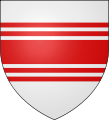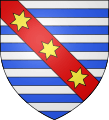Bar (heraldry)
In heraldry, a bar is an ordinary consisting of a horizontal band across the shield. If only one bar appears across the middle of the shield, it is termed a fess; if two or more appear, they can only be called bars. Calling the bar a diminutive of the fess is inaccurate, however, because two bars may each be no smaller than a fess.[1] Like the fess, bars too may bear complex lines (such as embattled, indented, nebuly, etc.).[1] The diminutive form of the bar (narrower than a bar yet wider than a cottise) is the barrulet, though these frequently appear in pairs, the pair termed a "bar gemel" rather than "two barrulets".[1]

Common ordinaries
A single bar placed across the top of the field is called a chief. A single bar placed over the center of the field is called a fess. Two to four of these appearing on a shield are called bars, and more than four are called barrulets.
Diminutives
Thin bars are termed barrulets. A still thinner bar or riband is known as a cottise. Cottises never appear alone and have no direction of their own, but are borne on each side of an ordinary (such as a fess, pale, bend or chevron). The ordinary thus accompanied by a cottise on each side is then described as "cottised", or these may even be "doubly cottised" (i.e. surrounded by four cottises, two along each side).[2]
The "closet" is described as a band of the thickness between a bar and a barrulet, but is rarely found.
A bar that has been "couped" (cut) at the ends so as not to reach the edges of the field is called a hamade, hamaide or hummet, after the town of La Hamaide in Hainaut, Belgium.[3] As a charge, it is almost always depicted in threes. The adjective is hummety.[4]
Barry and barruly
A field divided by many bars — often six, eight or ten parts with two alternating tinctures — is described as barry (of x, y and z, where x is the number of bars, y is the first (uppermost) tincture, and z is the second tincture). A field divided into five, seven or nine parts with two alternating tinctures is not called barry, however, but two, three or four bars.[5] A barry design consisting of ten or more parts is comparatively rare and is called barruly rather than barry.[5]
Examples
.svg.png) Argent, three bars gules
Argent, three bars gules.svg.png) Gules, four barrules indented Or
Gules, four barrules indented Or Sable, three bars gemelles Or
Sable, three bars gemelles Or Argent, a fess doubly cottised gules
Argent, a fess doubly cottised gules.svg.png) A bar gemel wavy cottised in the arms of the French commune of Berneuil-sur-Aisne
A bar gemel wavy cottised in the arms of the French commune of Berneuil-sur-Aisne Barry of ten sable and Or in the arms of the German state of Saxony
Barry of ten sable and Or in the arms of the German state of Saxony Lion barry of ten argent and gules in the arms of the German state of Hesse
Lion barry of ten argent and gules in the arms of the German state of Hesse.SVG.png) A bordure barry of ten argent and sable
A bordure barry of ten argent and sable.svg.png) Or, three hamades gules, the arms of La Hamaide in the Belgian province of Hainaut
Or, three hamades gules, the arms of La Hamaide in the Belgian province of Hainaut Arms of Richard de Valoines: Barruly of 14 argent and azure on a bend gules three mullets of six points or (1285)
Arms of Richard de Valoines: Barruly of 14 argent and azure on a bend gules three mullets of six points or (1285)
References
- Fox-Davies (1909), p. 119
- Fox-Davies (1909), pp. 113, 123
- "Frasnes-les-Avaing (Municipality, Hainaut Province, Belgium". Flags of the World. Retrieved 8 February 2013.
- Brooke-Little (1996), p. 112
- Fox-Davies (1909), p. 120
- Fox-Davies, Arthur Charles (1909). A Complete Guide to Heraldry. New York: Dodge Publishing. ISBN 0-517-26643-1. LCCN 09023803 – via Internet Archive.CS1 maint: ref=harv (link)
- Brooke-Little, J P (1996) [1973]. An heraldic alphabet (New and revised ed.). London: Robson Books. ISBN 9781861050779.CS1 maint: ref=harv (link)